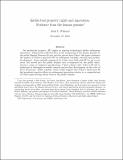Intellectual Property Rights and Innovation: Evidence from the Human Genome
Author(s)
Williams, Heidi L.
DownloadWilliams_Intellectual property.pdf (698.6Kb)
OPEN_ACCESS_POLICY
Open Access Policy
Creative Commons Attribution-Noncommercial-Share Alike
Terms of use
Metadata
Show full item recordAbstract
Do intellectual property (IP) rights on existing technologies hinder subsequent
innovation? Using newly-collected data on the sequencing of the human genome by
the public Human Genome Project and the private rm Celera, this paper estimates
the impact of Celera's gene-level IP on subsequent scienti c research and product
development. Genes initially sequenced by Celera were held with IP for up to two
years, but moved into the public domain once re-sequenced by the public e ort.
Across a range of empirical speci cations, I nd evidence that Celera's IP led to
reductions in subsequent scienti c research and product development on the order of
20 to 30 percent. Taken together, these results suggest that Celera's short-term IP
had persistent negative e ects on subsequent innovation relative to a counterfactual
of Celera genes having always been in the public domain.
Date issued
2013-02Department
Massachusetts Institute of Technology. Department of EconomicsJournal
Journal of Political Economy
Publisher
University of Chicago Press
Citation
Heidi L. Williams. Journal of Political Economy Vol. 121, No. 1 (February 2013), pp. 1-27.
Version: Author's final manuscript
ISSN
0022-3808
1537-534X